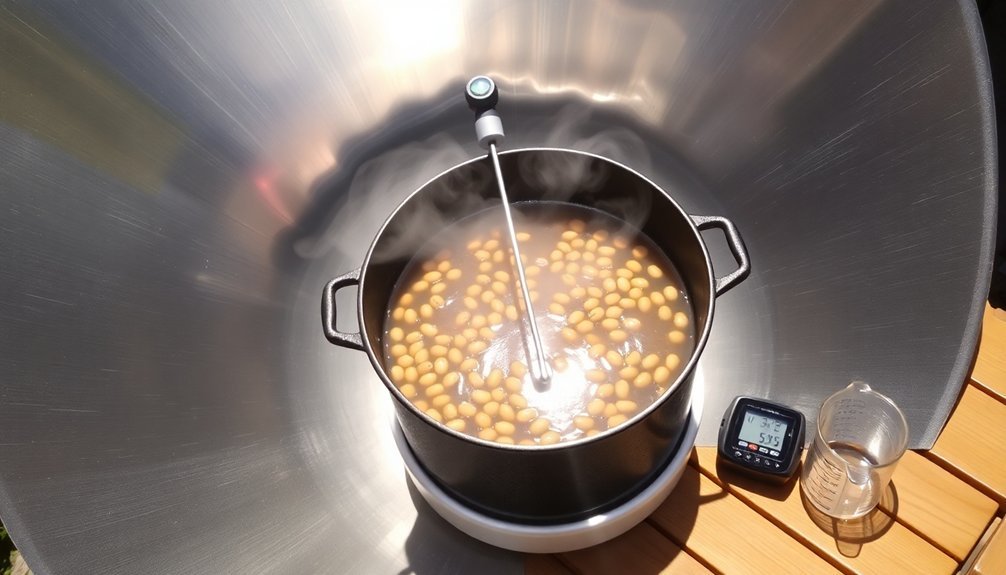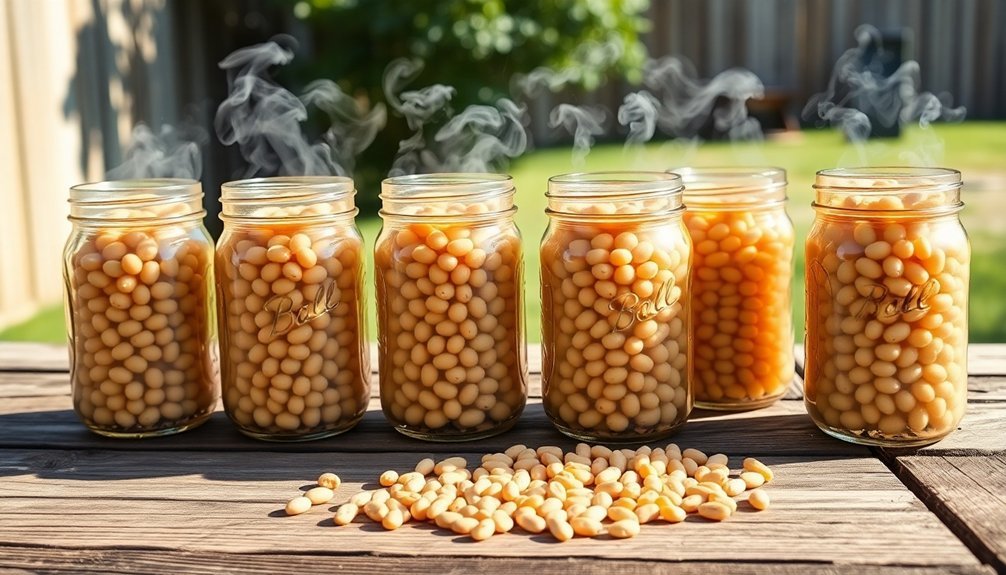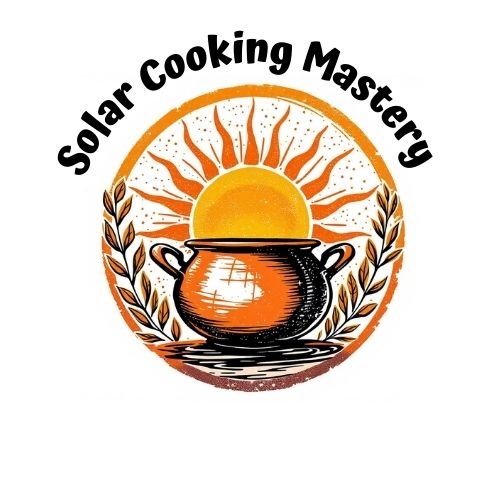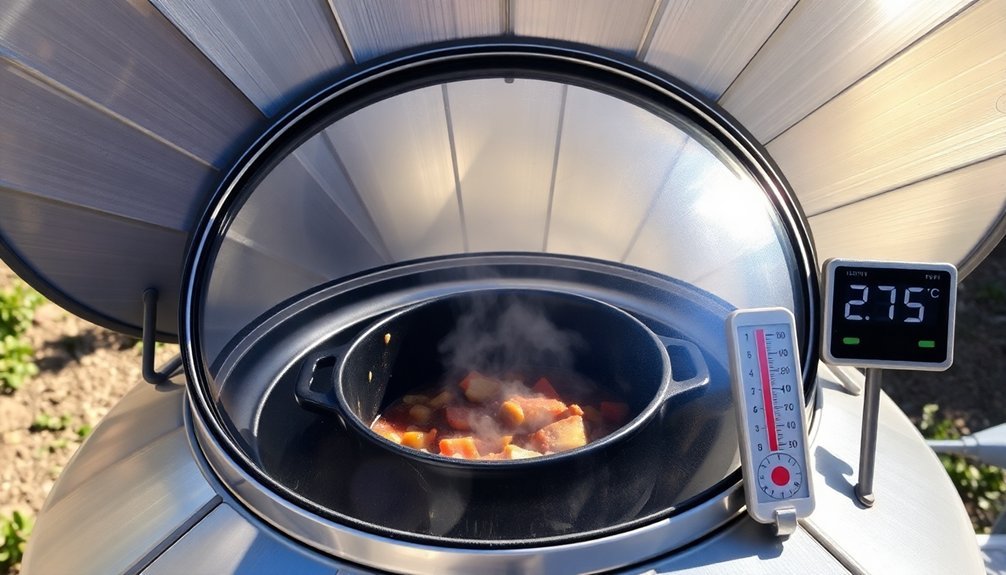When you're cooking dried beans outdoors with a solar cooker, expect the process to take 4-6 hours at lower elevations, similar to using a slow cooker. You'll need to soak your beans first for at least 4 hours or overnight, then cook them in a dark-colored pot with plenty of water coverage. Box solar cookers can reach up to 400°F, while parabolic cookers hit higher temperatures but need frequent adjustments. The exact cooking time depends on your altitude, weather conditions, and the type of solar cooker you're using. Understanding your specific setup and environmental factors will help you achieve perfectly tender beans every time.
Choosing Your Solar Cooking Setup

For successful outdoor bean cooking, selecting the right solar cooking setup is essential. You'll need to choose between different solar cooker types based on your specific needs and cooking style.
Box solar cookers work well for slow-cooking beans, while parabolic cookers offer higher temperatures but require more attention. Solar vacuum tube cookers provide excellent insulation and perform well even in lower light conditions.
Consider your cooking capacity requirements when selecting equipment. Most solar cookers can handle 4-8 meals at once, so choose one that matches your typical serving needs.
You'll also want to guarantee you have proper power storage – high-quality solar panels and deep-cycle batteries will keep your system running efficiently. Using an efficient and reliable power inverter system will ensure consistent energy supply for your cooking needs. If portability is important, look into all-in-one solar generators with built-in batteries and inverters.
For ideal bean cooking results, select dark-colored pots that absorb heat effectively. You'll need to factor in your location's altitude, as higher elevations require longer cooking times.
Remember that wind can impact performance, so choose a setup that includes wind protection features. Popular models like the Sun Oven or GoSun Grill offer reliable performance for bean cooking applications.
Bean Preparation Before Solar Cooking
Before you start solar cooking your dried beans, you'll need to soak them for at least 4 hours, though overnight soaking up to 24 hours will give you the best results.
Prior to soaking, sort through your beans carefully to remove any stones or debris that could affect your meal's quality.
After sorting, rinse your beans thoroughly with clean water both before and after the soaking process to guarantee they're ready for solar cooking. Once soaked, transfer the beans to a dark colored pot for optimal heat absorption during the solar cooking process.
Pre-Soaking Time Requirements
Proper bean soaking is an essential first step when preparing dried beans for solar cooking. You'll need to think about the size of your beans when determining soaking time, with small beans requiring 2 hours to overnight and medium to large beans needing 4 hours to overnight. While you can skip pre-soaking, unsoaked beans will take about 30 minutes longer to cook in your solar oven.
For the best results, you'll want to follow these key soaking guidelines:
- For overnight soaking, cover your beans with room temperature water and let them sit for 8-12 hours.
- For quick soaking, bring water to a boil, add beans, cover, remove from heat, and soak for 1 hour.
- Use enough water to cover beans by at least 2 inches, as they'll expand during soaking.
Your pre-soaking method will impact cooking time in your solar oven, which typically takes 4-6 hours at lower elevations. Like solar ovens, slow cooking in crockpots allows beans to become tender and flavorful through gradual heat application.
If you're cooking at higher altitudes, you'll need to start earlier and realign your solar oven more frequently. Remember that your solar oven can reach temperatures up to 350°F, making it as efficient as a crockpot for cooking beans when properly aligned with the sun.
Essential Cleaning Steps
When preparing dried beans for solar cooking, thorough cleaning and inspection steps guarantee your final dish will be free from unwanted debris and damaged beans.
Start by spreading your beans in a shallow layer on a pie plate, baking sheet, or bar pan. This makes it easier for you to spot and remove any foreign objects like stones, twigs, or leaves, as well as any broken or damaged beans.
Next, transfer your beans to a colander or strainer and rinse them thoroughly under cold running water. This step helps eliminate any remaining dirt or impurities that might affect the taste and quality of your dish. Be sure to drain excess water after the thorough rinsing process.
Make sure you're checking for uniform size during this process, as beans of similar size will cook more evenly.
Before moving on to soaking, perform a final inspection of your cleaned beans. You'll want to verify you haven't missed any debris and that all beans are intact and of similar size.
This careful attention to detail during the cleaning process will prevent unwanted textures in your finished dish and verify you're working with the highest quality ingredients for your solar cooking project.
Setting Up Your Outdoor Kitchen

You'll need a sturdy, level surface to set up your outdoor cooking station, which should include a heat source (like a grill or fire pit), large pot, cooking utensils, and a nearby water source.
If you're using an open fire, create a safe cooking area by clearing away debris and establishing a fire ring with rocks or bricks at least 10 feet from any structures or overhanging trees. Plan to include proper ventilation clearance around your cooking setup as recommended by safety guidelines.
Keep a bucket of water or fire extinguisher nearby for safety, and make sure your cooking setup allows proper ventilation while protecting the flame from strong winds.
Essential Equipment Needed
Setting up a successful outdoor kitchen for cooking dried beans starts with gathering the right equipment. You'll need a sturdy fire pit grill grate as your cooking surface and a large pot with a lid for the beans. A cast iron pan can come in handy for sautéing aromatics that'll enhance your beans' flavor.
For safety and convenience, make sure you've got these essential items:
- Heat-resistant gloves to protect your hands when handling hot cookware
- A water container nearby for emergency fire control
- Long-handled steel tongs for managing coals and adjusting your pot
Your basic tool kit should include a lighter for starting your fire and a hatchet for preparing properly sized firewood.
Don't forget aluminum foil – it's invaluable for creating a wind barrier around your cooking area or fashioning a makeshift lid if needed.
A digital thermometer will help you maintain consistent cooking temperatures, while a spray bottle allows you to control flare-ups that might affect your beans' cooking process.
Keep food storage containers ready for any leftover beans you'll want to save for later meals.
Safe Fire Setup
For safe outdoor bean cooking, proper fire setup forms the foundation of your outdoor kitchen safety. Start by choosing a cooking location away from any combustible materials, structures, or overhanging branches.
You'll need to create clear zones that separate your cooking area from seating and storage spaces to prevent accidents.
If you're using a gas-powered stove, guarantee proper ventilation to prevent dangerous gas buildup. Install your cooking equipment on a stable, level surface, and don't stretch power cords across walkways if you're using electric appliances. Instead, use built-in outlets whenever possible.
Keep all paths and aisles clear of obstacles that could cause trips or falls.
When setting up your fire pit or grill, avoid cooking during windy conditions, as strong gusts can spread embers. If you're using charcoal, only apply starter fluid to cold coals and store extra charcoal in a safe, dry location.
Remember to clean your cooking equipment regularly to prevent grease fires, and maintain clear access to fire safety equipment like extinguishers.
For complex setups involving permanent outdoor kitchen features, always seek professional installation help.
Weather Conditions and Cooking Times
When cooking dried beans outdoors, weather conditions play a critical role in determining cooking times and success. Wind can markedly impact your cooking process by dispersing heat around your cooking vessel, while humidity and temperature affect how your coals perform. You'll need to monitor these conditions and make adjustments throughout the cooking process.
To maintain consistent cooking temperatures, consider these essential factors:
- Wind speed and direction – Use a windshield to protect your cooking area and rotate your pot regularly to guarantee even heat distribution.
- Temperature and humidity levels – Expect longer cooking times in cold or humid conditions, and adjust your coal placement accordingly.
- Altitude considerations – Higher elevations require extended cooking times due to lower atmospheric pressure and reduced heat generation.
Most dried beans will take between 45-180 minutes to cook, depending on their size and whether you've pre-soaked them. Small beans cook fastest at 45-90 minutes, while larger varieties need 80-180 minutes.
You'll want to check your beans frequently for tenderness and adjust your cooking setup based on the weather conditions you're experiencing. Remember, older beans typically require longer cooking times regardless of environmental factors.
Solar Cooking Temperature Management

Successful solar cooking requires mastering three key temperature management techniques: pre-heating, monitoring, and adjustment. Begin by pre-heating your solar cooker for 15-20 minutes before adding your beans. This essential step guarantees you'll start with ideal cooking temperatures.
You'll need to monitor your cooker's temperature using an external gauge or built-in thermometer. Keep the internal temperature above 180 degrees Fahrenheit for food safety.
If you need to adjust the temperature, you can open or close the solar collection panels to control heat levels.
To maximize heating efficiency, use dark-colored cookware, which absorbs more sunlight and converts it to heat more effectively. Choose thin metal baking dishes with lids to retain heat and moisture while allowing quick temperature changes.
Position your cooker at the best sun angle using a sun angle finder or by checking shadows.
Keep the reflective surfaces clean to maintain ideal heat generation. If you're using the slow-cooker method, position your solar oven southward.
Remember that insulation is vital – verify your cooking area is level and well-insulated to maintain consistent temperatures throughout the cooking process.
Monitoring Bean Doneness Outdoors
Testing beans for doneness outdoors requires three essential checkpoints: texture, taste, and timing. When you're cooking beans outside, you'll need to be extra vigilant since outdoor conditions can affect cooking times markedly.
You'll want to test your beans every 15-30 minutes, keeping in mind that they'll continue cooking even after you remove them from heat.
To confirm your beans are properly cooked outdoors, follow these critical steps:
- Press a bean against the roof of your mouth – it should be tender throughout but maintain its shape without being mushy.
- Test multiple beans from different areas of your cooking vessel, as heating may be uneven outdoors.
- Allow for extra cooking time to compensate for variable outdoor temperatures and altitude effects.
Remember that you're looking for beans that are completely tender but not falling apart. If you're cooking at a higher altitude, you'll need to extend your cooking time since water boils at a lower temperature.
Don't rush the process – it's better to cook beans slowly and thoroughly than to serve them undercooked, especially when cooking outdoors where temperature control can be challenging.
Storing Sun Cooked Beans

Proper storage techniques guarantee your sun-cooked beans stay fresh and safe for future meals. You'll need airtight containers made of glass or food-grade materials to prevent moisture and pest infiltration.
Before storing, let your beans cool completely and remove any broken pieces or debris. Always label your containers with dates and contents to track freshness.
For short-term storage, keep your beans in the refrigerator for 3-5 days. Cover them with cooking liquid or water in airtight containers to maintain moisture. Glass containers work best as they won't transfer metallic tastes to your beans.
If you're planning for long-term storage, freezing is your best option. You can freeze cooked beans for up to 3 months in airtight containers or freezer bags. Portion them out before freezing for easier thawing, and don't forget to cover them with liquid.
Store your non-frozen beans in a cool, dry, and dark place. You can add desiccants or oxygen absorbers to control humidity. Keep containers away from direct sunlight and heat sources to maintain quality and prevent spoilage.
Frequently Asked Questions
Can I Mix Different Types of Dried Beans When Solar Cooking?
Yes, you can mix different types of dried beans when solar cooking, but you'll need to monitor cooking times carefully. Pre-soak them overnight and expect cooking to take 1.5-5 hours for best results.
What Happens if Animals Approach My Outdoor Cooking Setup?
If animals approach your cooking setup, don't run. Stay calm, make noise, and slowly back away. Keep your food secured, maintain a clean area, and use bear-proof containers to prevent future encounters.
Should I Adjust Seasoning Differently for Solar-Cooked Beans Versus Stovetop?
You'll want to season solar-cooked beans mid-cooking instead of early on. Add salt halfway through the process, as the slower cooking method makes beans softer and more susceptible to absorbing flavors.
Are Glass or Metal Containers Better for Outdoor Bean Cooking?
You'll find metal containers are better for outdoor bean cooking. They're more durable, conduct heat evenly, and won't break. While glass is non-reactive, its fragility and thermal shock risks make it impractical outdoors.
Can I Use a Solar Oven to Reheat Previously Cooked Beans?
Yes, you can easily reheat cooked beans in a solar oven. It'll take 1-2 hours in a covered container. Just add minimal water, position your oven toward the sun, and adjust occasionally for ideal exposure.
In Summary
You'll find that solar cooking dried beans outdoors takes patience but delivers delicious results. Once you've mastered monitoring temperature, weather conditions, and cooking times, you can expect your beans to be ready in 4-6 hours of good sunlight. Remember to soak them overnight and keep your setup stable. With practice, you'll enjoy tender, eco-friendly beans cooked entirely by the sun's natural energy.





Leave a Reply